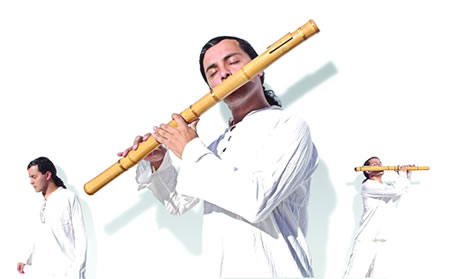
World Flutes Master
Peace web theme set courtesy of Crystal Cloud Graphics web set icon
Crystal Cloud Graphics
Crystal Cloud Graphics


Cuidemos
el Medio Ambiente
el Medio Ambiente

comprar

Clarintet
The clarinet is a musical instrument in the woodwind family. The name derives from adding the suffix -et meaning little to the Italian word clarino meaning a particular type of trumpet, as the first clarinets had a strident tone similar to that of a trumpet. The instrument has an approximately cylindrical bore, and uses a single reed.
The clarinet developed from a Baroque instrument called the chalumeau. This instrument was similar to a recorder, but with a single reed mouthpiece similar to that of the modern clarinet and a cylindrical bore. Lacking a register key, it was played mainly in its fundamental register, with a limited range of about one and a half octaves. It had eight finger holes, like a recorder, plus two keys for its two highest notes.
Around the turn of the 18th century the chalumeau was modified by converting one of its keys into a register key to produce the first clarinet. This development is usually attributed to a German instrument maker named Johann Christoph Denner, though some have suggested his son Jacob Denner was the inventor.
Clarinets actually comprise a family of instruments of differing sizes and pitches. It is the largest such instrument family, with more than two dozen types. Of these many are rare or obsolete, and music written for them is usually played on one of the more common size instruments. The unmodified word clarinet usually refers to the B? soprano clarinet, by far the most common clarinet.
The clarinet is a musical instrument in the woodwind family. The name derives from adding the suffix -et meaning little to the Italian word clarino meaning a particular type of trumpet, as the first clarinets had a strident tone similar to that of a trumpet. The instrument has an approximately cylindrical bore, and uses a single reed.
The clarinet developed from a Baroque instrument called the chalumeau. This instrument was similar to a recorder, but with a single reed mouthpiece similar to that of the modern clarinet and a cylindrical bore. Lacking a register key, it was played mainly in its fundamental register, with a limited range of about one and a half octaves. It had eight finger holes, like a recorder, plus two keys for its two highest notes.
Around the turn of the 18th century the chalumeau was modified by converting one of its keys into a register key to produce the first clarinet. This development is usually attributed to a German instrument maker named Johann Christoph Denner, though some have suggested his son Jacob Denner was the inventor.
Clarinets actually comprise a family of instruments of differing sizes and pitches. It is the largest such instrument family, with more than two dozen types. Of these many are rare or obsolete, and music written for them is usually played on one of the more common size instruments. The unmodified word clarinet usually refers to the B? soprano clarinet, by far the most common clarinet.









